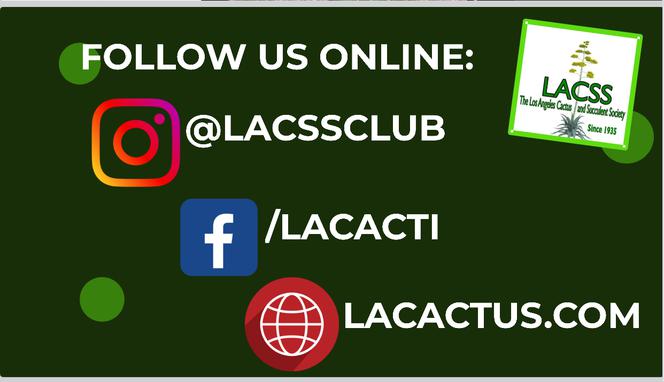Los Angeles
Cactus and Succulent Society
Come and Visit!
Welcome to the website of the Los Angeles Cactus and Succulent Society. Our nearly 200 members come from throughout the southland and share a passion for cacti and succulents. Throughout the history of LACSS, many of the most prominent researchers, authors, and collectors of the succulent world have been leaders and members of our society.
LACSS meets monthly in the San Fernando Valley to enjoy stimulating presentations, hands-on workshops, plant sales, mini-shows, raffles, trading, and other activities. In addition, LACSS offers field trips to member gardens, nurseries, and private collections. We serve the greater community by offering free educational activities, and presenting an exciting annual festival in April or June, and a Fall Sale.
In order to share the joys and benefits of collecting and cultivating cacti and succulents, we invite you to check out our general meetings on the 1st Thursday of each month at ONEgeneration Senior Enrichment Center at 18255 Victory Blvd.
Doors open at 6:15 for the Social Hour, Ask an Expert, and much more. The business meeting starts promptly at 7pm. Attendance is FREE and open to the public. Each new visitor receives a free plant! We hope to see you at a meeting soon.
This page requires a password
Renew your membership NOW!
REFRESHMENT REMINDER
Our next meeting is Feb 5, 2026. Last Name beginning E,F,G, and H please bring treats! If you missed your month this is a great time to bring a treat to share.
It is a collective effort that we provide refreshments for our members at the meeting! As you know, bringing refreshments to the meeting is a way to make our meetings more enjoyable and welcoming for everyone.
Now we are beginning with the first letter of your Last name so if your last name begins with the letter please bring in something to share.
February E,F,G, and H.
We kindly ask that each member brings a small contribution of snacks or drinks to share with the group. A lot of us are coming straight from work and appreciate that we are mindful of empty stomachs.
Examples of refreshments that you could bring include:
Appetizers / Sides Cookies or pastries Fruit or vegetables Chips and dip Finger food Pizza
Please bring your contribution in a “disposable” dish!
If bringing refreshments is a difficulty, we ask that you leave a donation in the “Donation Jar” at the Refreshment Table. The club relies on your contribution to continue supplying our membership with sustenance.
We appreciate your cooperation and look forward to seeing you at the meeting.
Thank you,
LACSS
Meeting
Feb 5, 2026
Doors open 6:15PM
One Generation
18255 Victory Blvd
Reseda CA
Presentation: Nature’s Geometry – Succulents
Since 1973, Russel Ray has been fascinated with the Fibonacci sequence of numbers and how they are expressed in nature. Russel uses the Fibonacci numbers in his presentation to at the shape of plants, the number of plant ribs, the number of spine areolas, golden angles, divergence angle, golden triangles, golden squares, golden rectangles, triangles, stars pentagrams, circles, fractals, hearts, and golden spirals and has published a book called Nature’s Geometry – Succulents.
Get ready for some giant Cardons, ancient Ferocactus & procumbent Pachycauls! This presentation is different than we are used to and will be fascinating!
Russel Ray was born in Kingsville, Texas, and has lived in the San Diego area since 1993. Self-employed his entire career, he is a serial entrepreneur specializing in guiding companies through startup and growth phases. His experience spans a wide range of industries, including telecommunications, construction, real estate, consulting, publishing, and photography.
February Plants of the Month:
Othonna
Cleistocactus, Espostoa
Program
Thursday February 5, 2026
Russel Ray
Events
Plant Day 2026
at LA Public Library.
If you like to talk about our great club and the plants we love Contact Ron B
818-571-6469
Plant Day 2026
Jan 31
Central Library
630 W 5th St
Los Angeles 90071
10 to 3pm
Los Angeles
Cactus and Succulent Society
Plant Con Los Angeles
February 21 - 22, 2026 | Magic Box Los Angeles
10am - 6pm
1933 S Broadway, Los Angeles, CA 90007
San Gabriel Cactus and Succulent Society Winter Show and Sale
Feb 20 & 21
Arcadia Masonic Center, 50 W Duarte Rd., Arcadia, CA
Sale — Friday-Saturday 9am-5pm,
Show — Saturday 9am-5pm,
Info: Manny Rivera 626-780-6957 or James Lemos 626-201-5519





